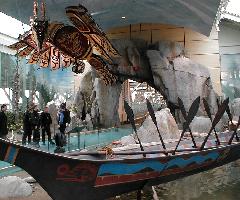
Pacific Passage within the new 18,000-square-metre expansion of the ITB continues the
airport's award-winning artistic theme and direction. This thematic area is a unique
depiction of a coastal beach - complete with water, sandy shores, and rugged cliffs. It
features native artwork against a scenic backdrop with sounds of wildlife amongst live
plants and trees. Of all the new native artwork, perhaps most striking is the enormous
Raven sculpture crafted by First Nations artist Connie Watts. Inspired by her grandmother,
this impressive work is suspended from the ceiling, dwarfing those below. In addition,
works by artists Tim Paul, Stephen Bruce, Lyle Wilson, and Stan Wamis are also featured.
Audio Environment
The challenge was to create an ambient soundscape to compliment the natural landscape
exhibit in this thematic area. The mandate was to use sound to add realism and motion to
"bring to life" an otherwise static artificial environment. This had to be done
with subtlety, so as not to overpowering the scene - replicating an outdoor soundscape
such that its presence would not be nearly as noticeable as its absence.
An overall stereo soundscape loop is replicated through a distributed overhead system
and a number of speakers deliberately aimed at the glass walls running the length of the
environment. These combine to create a non-directional, ambient sound for both the ocean
and forest halves of the landscape. This soundtrack consists of low-key, non-directional
sounds to form a background texture.
 Five key First Nation sculptures are provided with dedicated spot sound
effects that are triggered at random - the delay between each effect is also randomised.
Further spot speakers are concealed across the ocean and forest landscapes, and are also
randomly triggered. These feature appropriate environmental effects such as bird and
animal sounds to add life to the beach and forest. A dedicated sound loop of waves on
rocks (just out of the visitor's sight) adds a dynamic element to the "ocean." Five key First Nation sculptures are provided with dedicated spot sound
effects that are triggered at random - the delay between each effect is also randomised.
Further spot speakers are concealed across the ocean and forest landscapes, and are also
randomly triggered. These feature appropriate environmental effects such as bird and
animal sounds to add life to the beach and forest. A dedicated sound loop of waves on
rocks (just out of the visitor's sight) adds a dynamic element to the "ocean."
To achieve high-reliability with near-zero maintenance, all audio material is contained
in solid-state EEPROM-based playback units with no moving parts.
Show Control
Since passengers arrive in this area in "clumps" at certain portions of the
day, it was decided that the soundscape should "sleep" during idle periods. To
this end microwave motion detectors are used to detect passengers approaching each of the
two entrances to the area.
 When triggered by the motion detectors, the
solid-state playback units containing the overall ambient soundscape are started in
looping mode, and the lighting system is triggered. For each spot effect, one of a number
of speaker lines is switched to the output of the associated spot playback amplifier, and
one of a number of available audio clips is selected at random. After completion of each
spot clip, there is a delay before the next speaker line and clip are randomly selected -
this delay is also random. This speaker and clip selection process continues until the
controller once again goes idle (i.e.: when no additional motion detector triggers have
been received for a pre-defined time-out period). When triggered by the motion detectors, the
solid-state playback units containing the overall ambient soundscape are started in
looping mode, and the lighting system is triggered. For each spot effect, one of a number
of speaker lines is switched to the output of the associated spot playback amplifier, and
one of a number of available audio clips is selected at random. After completion of each
spot clip, there is a delay before the next speaker line and clip are randomly selected -
this delay is also random. This speaker and clip selection process continues until the
controller once again goes idle (i.e.: when no additional motion detector triggers have
been received for a pre-defined time-out period).
A programmable logic
controller (PLC) is used to accomplish this control. Manual controls are provided for
de-bugging and system RESET in the unlikely event of a controller lock-up. The audio is
immediately killed when the emergency paging system is activated. |

